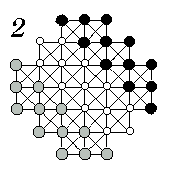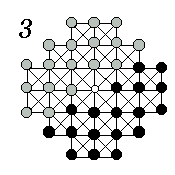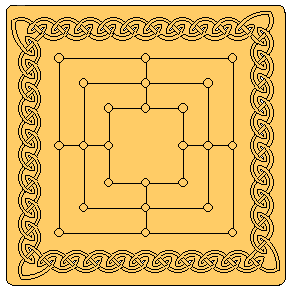|
Fox and Geese
A classic medieval game for two players
 Starting. One player has 17 white geese, arranged on the board as shown at right (Figure 1). The other player has one black fox, starting on the center of the board or on any space desired. Starting. One player has 17 white geese, arranged on the board as shown at right (Figure 1). The other player has one black fox, starting on the center of the board or on any space desired.
Moving. The fox moves first, one step in any direction along the lines to an adjacent empty spot. The fox may also jump, as in checkers, over a goose to an empty space immediately on the other side of the goose along the same straight line. The fox may make multiple jumps but does not have to jump. A jumped goose is removed from the board. The geese may move only along the lines one step at a time and may not move backwards. The geese may not jump.
Objective. The goal of the geese is to pen in the fox so he cannot move. The goal of the fox is to take enough geese to prevent them from penning him up.
Variations. If you find that under the above rules the geese usually win, omit the two front geese. If the geese are still too strong, play it so that the geese may move only forward or diagonally, not sideways.


Chinese Checkers Variant
Non-capturing strategy game for two players
 Starting. Set up 12 pieces for each player as shown in the diagram at right (Figure 2). Starting. Set up 12 pieces for each player as shown in the diagram at right (Figure 2).
Moving. Pieces may slide one space to an adjacent empty circle in any direction along the lines except backwards, or jump over other pieces following the lines, if the space directly on the other side of the piece being jumped is empty. Multiple jumps may be made. Jumps may go in any direction as long as the piece does not end up farther back than where it started that turn. Jumped pieces stay on the board.
Objective. The first player to get all 12 pieces into the other player's start position wins.


Solitaire
Classic jumping puzzles for one player
 The traditional French 37-space board. This jumping puzzle starts with every spot on the board covered by a stone, except for the center (Figure 3, right). Jump stones over each other as in checkers, always over a single stone to an empty space immediately on the other side of that stone, and only along the lines on the board. Every move is a jump. Jumped stones are removed from the board. The objective is to end up with only one stone (a solitary stone, hence the name Solitaire) remaining on the board, preferably on the center spot. What is your best score for fewest number of moves? For a more difficult challenge, make no diagonal jumps. The traditional French 37-space board. This jumping puzzle starts with every spot on the board covered by a stone, except for the center (Figure 3, right). Jump stones over each other as in checkers, always over a single stone to an empty space immediately on the other side of that stone, and only along the lines on the board. Every move is a jump. Jumped stones are removed from the board. The objective is to end up with only one stone (a solitary stone, hence the name Solitaire) remaining on the board, preferably on the center spot. What is your best score for fewest number of moves? For a more difficult challenge, make no diagonal jumps.

| 


